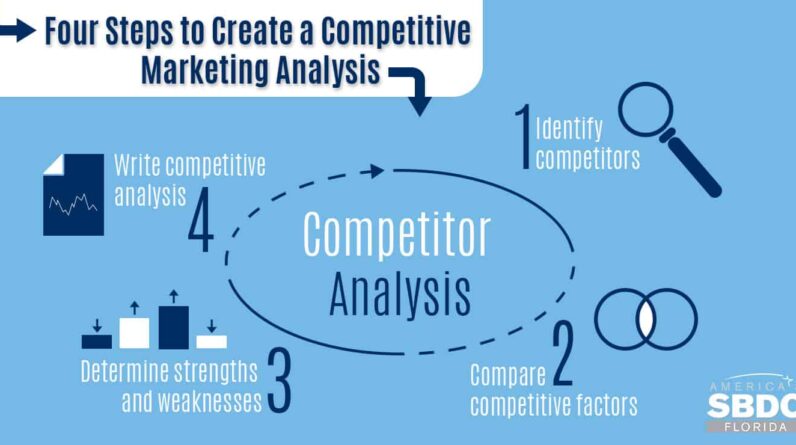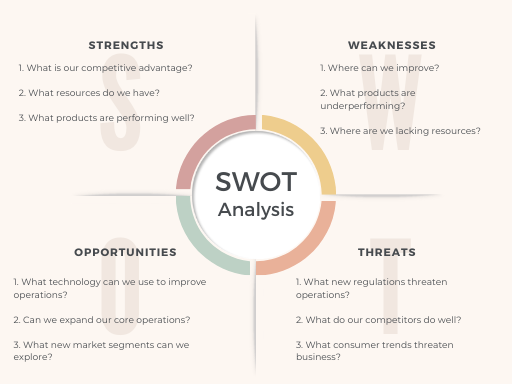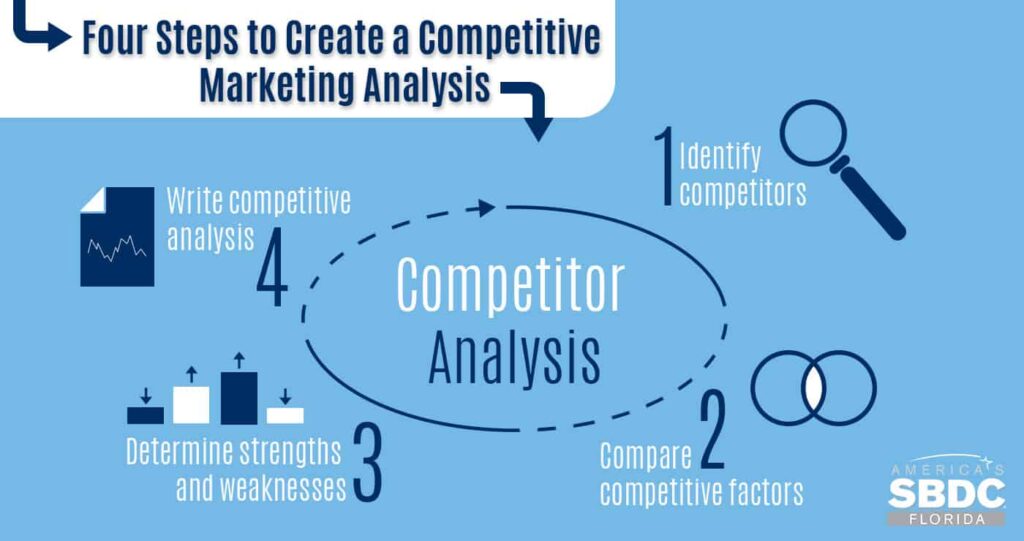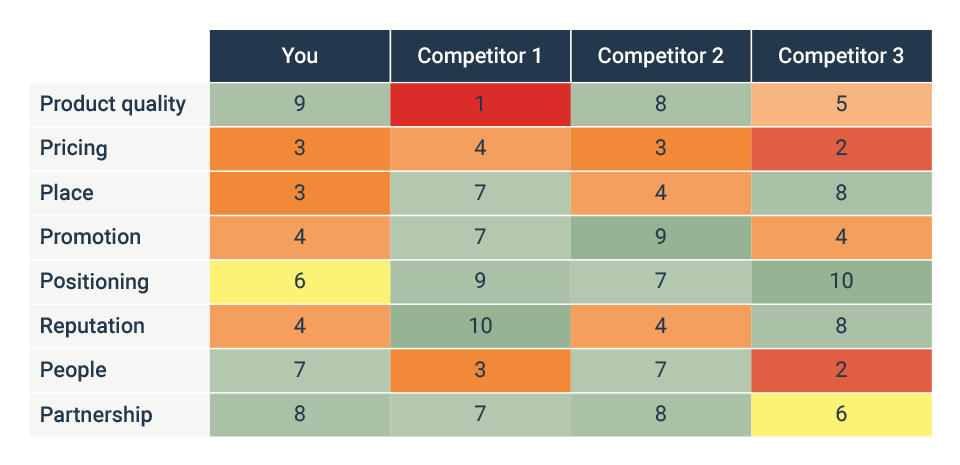
So, you have a client who wants to gain a competitive edge in their industry, but they’re not quite sure where to start. That’s where conducting a competitive analysis comes into play. By identifying and analyzing your client’s competition, you can gain valuable insights into what they’re doing right (and wrong), and use that information to help your client stand out from the crowd. In this article, we’ll discuss the essential steps to conducting a successful competitive analysis for your client’s business, giving you the tools you need to help them thrive in a competitive market.
Research Competition
Identify top competitors
To conduct a comprehensive competitive analysis for a client’s business, the first step is to identify the top competitors in the industry. These are the companies that pose the greatest threat to the client’s market share and customer base. By identifying these competitors, you can focus your analysis on understanding their strategies, products/services, and marketing efforts.
Gather information on competitors
Once you have identified the top competitors, the next step is to gather information about them. This can include researching their products/services, pricing strategies, target audience, marketing campaigns, online presence, and distribution channels. Gathering detailed information on competitors will provide valuable insights into their strengths, weaknesses, and areas for improvement, which can inform the client’s own strategies.
Analyze competitors’ products/services
After gathering information on the competitors, it is important to analyze their products/services. This involves understanding the unique selling propositions, features, and benefits that competitors offer to attract customers. By evaluating the competitors’ products/services, the client can identify areas where they can differentiate themselves or develop innovative solutions to meet customer needs. This analysis will also help the client gauge the quality and value of their own offerings in comparison.
Evaluate Market Share
Identify industry market leaders
To conduct an effective competitive analysis, it is crucial to identify the industry market leaders. These are the companies that have the largest market share and a strong presence in the industry. By identifying the market leaders, the client can gain insights into their market dominance, strategies, and customer loyalty. This knowledge can help the client understand the competitive landscape and make informed decisions about their own market positioning.
Determine market share
Once the market leaders have been identified, it is important to determine their market share. This can be done through market research, industry reports, and analyzing sales data. By understanding the market share of the competitors, the client can gauge their own position in the market and identify opportunities for growth. This analysis will also help the client understand the potential impact of their strategies on the overall market dynamics.
Analyze market trends
In addition to assessing market share, it is crucial to analyze the market trends. This involves studying the industry dynamics, customer preferences, technological advancements, and economic factors that influence the market. By analyzing market trends, the client can identify emerging opportunities and potential threats. This analysis will also help the client stay ahead of the competition and adapt their strategies to meet the evolving needs of the target audience.

Assess Pricing Strategy
Evaluate competitors’ pricing
One of the key aspects of a competitive analysis is evaluating competitors’ pricing strategies. This involves studying the pricing models, pricing tiers, discounts, and promotions offered by the competitors. By understanding the pricing strategies of the competitors, the client can determine how their own pricing compares and position themselves accordingly. This analysis will also help the client identify opportunities for pricing optimization and value-added offerings.
Compare pricing models
In addition to evaluating competitors’ pricing, it is important to compare their pricing models. This involves looking at the pricing structures, such as subscription-based, one-time purchase, or freemium models. By comparing the pricing models, the client can understand the different approaches taken by competitors and assess the feasibility of implementing a similar model or exploring alternative pricing strategies. This analysis will also help the client identify potential gaps or price points that may attract or deter customers.
Analyze pricing strategies
Lastly, it is crucial to analyze the overall pricing strategies of the competitors. This involves studying their pricing positioning in the market, price differentials between products/services, and pricing relative to perceived value. By analyzing the pricing strategies, the client can gain insights into the competitive pricing landscape and make informed decisions about their own pricing strategy. This analysis will also help the client identify potential opportunities for price adjustments, discounts, or bundling options.
Analyze Target Audience
Identify target audience
To conduct an effective competitive analysis, it is important to identify the target audience of the client’s business. This involves understanding the demographics, psychographics, and behavioral characteristics of the customers who are most likely to be interested in the client’s products/services. By identifying the target audience, the client can tailor their marketing efforts, messaging, and product development to better meet the needs and preferences of their customers.
Gather data on audience preferences
Once the target audience has been identified, the next step is to gather data on their preferences. This can include conducting surveys, interviews, focus groups, or analyzing market research reports. By understanding the audience preferences, the client can identify key buying motivations, pain points, and desired features. This data will help the client develop targeted marketing campaigns and product/service enhancements that resonate with their target audience.
Analyze competitors’ audience targeting
In addition to understanding the target audience for the client’s business, it is important to analyze how competitors are targeting their audience. This involves studying their marketing campaigns, messaging, and customer engagement strategies. By analyzing competitors’ audience targeting, the client can gain insights into the effectiveness of different marketing approaches, identify gaps in the market, and differentiate their own messaging to stand out from the competition. This analysis will also help the client identify potential partnerships or collaborations with complementary businesses that target the same audience.

Study Marketing Strategies
Evaluate competitors’ advertising efforts
To conduct a comprehensive competitive analysis, it is important to evaluate competitors’ advertising efforts. This involves studying their advertising campaigns, messaging, creative assets, and media placements. By evaluating competitors’ advertising efforts, the client can gain insights into the most effective channels, messaging strategies, and creative approaches in their industry. This analysis will help the client refine their own advertising strategy and optimize their marketing budget.
Examine marketing channels and tactics
In addition to evaluating advertising efforts, it is crucial to examine the marketing channels and tactics used by competitors. This involves studying their presence across different platforms, such as social media, email marketing, content marketing, and influencer partnerships. By examining competitors’ marketing channels and tactics, the client can identify new opportunities for customer engagement, identify gaps in the market, and refine their own marketing mix. This analysis will also help the client stay ahead of trends and adapt their marketing strategies to effectively reach their target audience.
Analyze competitors’ social media presence
Lastly, it is important to analyze competitors’ social media presence. This involves studying their social media profiles, content strategy, engagement levels, and follower demographics. By analyzing competitors’ social media presence, the client can gain insights into the types of content that resonate with their target audience, identify potential influencers or brand ambassadors, and refine their own social media strategy. This analysis will also help the client identify opportunities for content collaboration or partnerships to expand their reach and visibility.
Assess Strengths and Weaknesses
Identify competitors’ strengths and weaknesses
To effectively compete in the market, it is important to assess competitors’ strengths and weaknesses. This involves analyzing their core competencies, unique selling propositions, customer loyalty, and areas for improvement. By identifying competitors’ strengths and weaknesses, the client can understand the competitive landscape and determine how to differentiate their own business. This analysis will also help the client identify potential opportunities to leverage their own strengths and mitigate their weaknesses.
Compare strengths and weaknesses to client’s business
Once competitors’ strengths and weaknesses have been identified, it is important to compare them to the client’s business. This involves evaluating the client’s core competencies, value proposition, customer satisfaction, and areas for improvement. By comparing strengths and weaknesses, the client can determine how they stack up against the competition and identify areas where they can gain a competitive advantage. This analysis will also help the client prioritize their resources and strategies to effectively compete in the market.
Determine areas of competitive advantage
Based on the comparison of strengths and weaknesses, it is crucial to determine the areas of competitive advantage for the client’s business. This involves identifying the unique attributes, capabilities, or offerings that differentiate the client from their competitors. By determining areas of competitive advantage, the client can focus their resources, marketing efforts, and innovation on these areas. This analysis will also help the client communicate their value proposition effectively and attract customers who resonate with their strengths.

Evaluate Online Presence
Analyze competitors’ websites
To conduct an effective competitive analysis, it is important to analyze competitors’ websites. This involves studying their website design, user experience, navigation, content strategy, and call-to-action. By analyzing competitors’ websites, the client can gain insights into best practices, identify potential gaps or opportunities, and optimize their own website to attract and convert customers. This analysis will also help the client understand how competitors are positioning themselves online and differentiate their own online presence.
Assess competitors’ search engine optimization
In addition to evaluating competitors’ websites, it is crucial to assess their search engine optimization (SEO) efforts. This involves studying their keywords, meta tags, content optimization, backlink profiles, and search engine rankings. By assessing competitors’ SEO, the client can gain insights into the keywords and strategies that are driving organic traffic, identify potential gaps or opportunities, and optimize their own website to improve search visibility. This analysis will also help the client understand how competitors are leveraging SEO to attract customers and refine their own SEO strategy.
Evaluate competitors’ online visibility
Lastly, it is important to evaluate competitors’ overall online visibility. This involves analyzing their presence on search engines, social media platforms, industry directories, review websites, and online marketplaces. By evaluating competitors’ online visibility, the client can gain insights into the channels that are driving traffic and conversions, identify potential partnerships or collaborations, and optimize their own online presence. This analysis will also help the client understand the broader digital landscape and identify opportunities to expand their reach and visibility.
Examine Customer Reviews
Analyze online customer reviews
To conduct an effective competitive analysis, it is important to analyze online customer reviews. This involves studying the reviews and ratings posted by customers on review websites, social media platforms, and industry forums. By analyzing online customer reviews, the client can gain insights into the strengths and weaknesses of competitors’ products/services, identify areas for improvement, and tailor their own offerings to meet customer expectations. This analysis will also help the client understand the reputation of competitors and build trust with their own customers.
Review customer feedback on competitors’ products/services
In addition to analyzing online customer reviews, it is crucial to review the feedback that customers provide directly to the competitors. This can include customer surveys, feedback forms, or customer service interactions. By reviewing customer feedback on competitors’ products/services, the client can gain insights into their customer satisfaction levels, common pain points, and areas for improvement. This analysis will help the client develop products/services that address customer needs and deliver a superior customer experience.
Identify areas for improvement based on customer feedback
Based on the analysis of online customer reviews and feedback, it is important to identify specific areas for improvement. This involves highlighting the common themes, complaints, or suggestions provided by customers. By identifying areas for improvement, the client can refine their own products/services, customer service, or operational processes to gain a competitive advantage. This analysis will also help the client prioritize their resources and strategies to address customer needs effectively.

Assess Distribution Channels
Examine competitors’ distribution networks
To effectively compete in the market, it is important to examine competitors’ distribution networks. This involves studying their partnerships, suppliers, distribution channels, and logistics. By examining competitors’ distribution networks, the client can gain insights into their reach, efficiency, and customer accessibility. This analysis will help the client identify potential partners or suppliers, optimize their distribution channels, and improve their overall logistics and delivery processes.
Analyze suppliers and partnerships
In addition to examining distribution networks, it is crucial to analyze competitors’ suppliers and partnerships. This involves studying the relationships, quality standards, and cost structures of suppliers and the strategic partnerships they have formed. By analyzing suppliers and partnerships, the client can gain insights into potential opportunities for cost savings, quality enhancements, or strategic alliances. This analysis will also help the client build strong relationships with suppliers and develop partnerships that support their business goals.
Evaluate competitors’ logistics and delivery
Lastly, it is important to evaluate competitors’ logistics and delivery processes. This involves studying their order fulfillment, shipping options, delivery speed, and customer service levels. By evaluating competitors’ logistics and delivery, the client can gain insights into industry best practices, identify potential gaps in the market, and optimize their own processes to deliver a superior customer experience. This analysis will also help the client refine their operational efficiency and differentiate themselves based on the quality of their logistics and delivery.
Benchmark Key Metrics
Identify relevant key performance indicators (KPIs)
To measure success and track progress, it is important to identify the relevant key performance indicators (KPIs) for the client’s business. This involves selecting the metrics that align with the client’s goals, such as revenue growth, customer acquisition, customer retention, market share, or brand awareness. By identifying relevant KPIs, the client can establish a baseline and track their performance against the competition. This analysis will also help the client identify areas for improvement and set benchmarks for success.
Compare KPIs between client and competitors
Once the relevant KPIs have been identified, it is crucial to compare them between the client and competitors. This involves analyzing the performance metrics and benchmarks of the client against the industry leaders and other competitors. By comparing KPIs, the client can gain insights into their relative performance, identify areas of strength or weakness, and determine the strategies that are working well for the competition. This analysis will help the client set realistic goals, understand the market dynamics, and make data-driven decisions to improve their performance.
Set benchmarks for improvement
Based on the comparison of KPIs, it is important to set benchmarks for improvement. This involves establishing targets or milestones that the client aims to achieve in specific time frames. By setting benchmarks for improvement, the client can track their progress, measure the effectiveness of their strategies, and stay motivated to continuously improve their performance. This analysis will also help the client prioritize their resources and strategies to achieve their business goals.






